
Wine Culture and Information since 2002 - Volume 22
 Wine Culture and Information since 2002 - Volume 22 |
|
Contrasts of Locorotondo and Langhe FavoritaTwo different wines in every aspect, from geographical to enological ones, bring in our glasses the contrasts of two equally different regions: Apulia and Piedmont |
|
When one thinks about the viticulture of Apulia and Piedmont, the style of wine which is mainly associated with both regions is unequivocally red. As for Piedmont, the association with Nebbiolo and Barbera is evidently implicit: Barolo, Barbaresco, Barbera d'Alba and d'Asti, wines produced with these grapes, are probably the most mentioned ones, although the list is much longer. The same consideration can obviously be made for Apulia, a region characterized – in the common enological imagination – for its red wines. Primitivo di Manduria, Salice Salentino Rosso, the many interpretations of Negroamaro represent, also in this case, a clearly reductive and limited list if compared with the variety of the enological production of Apulia. In both regions, however, the production of white wines is particularly active and – although in many cases they do not enjoy the reputation of the red wines produced in the respective regions – they play a very important and identifying role in both territories. The two wines we are going to pour into the glasses of this month's tasting by contrast are, in fact, two interesting representatives of the enology of the whites of Piedmont and Apulia, certainly among the best known. In fact, our tasting by contrast will have as protagonists Langhe Favorita – representing Piedmont – and Locorotondo, among the best known white wines of Apulia. The two wines differ, in addition to their geographical origin, for their enological characteristics and, in particular, the composition of the grapes. In fact, it should be noted Langhe Favorita is generally a mono-varietal wine, that is, produced with only one grape, even if – it must be said – the production disciplinary allows the use of other white grapes grown in Piedmont. Locorotondo, on the other hand, is always produced with at least two different grapes and, according to the production disciplinary, it can also be added other indigenous white varieties of Apulia.
|
|
Locorotondo wines have been among the first whites of Apulia to be known outside the borders of this region and, for certain aspects and for a long time, they have represented – in the imagination of enthusiasts – the Apulian white wine par excellence. Locorotondo wines are classified as Denominazione d'Origine Controllata (DOC, Denomination of Controlled Origin) and the territories in which production is allowed is part of the provinces of Bari and Brindisi. Locorotondo represents a particular case in the viticultural and enological scenario of Apulia. In this area, in fact, only white berried grapes are grown and all the wines belonging to the DOC are white, including sparkling and sweet styles. A decidedly particular fact, considering the vocation and tradition of Apulia for the production of red and rosé wines. In the vineyards of Locorotondo, in fact, dominate Verdeca and Bianco d'Alessano, two indigenous white grape varieties of Apulia. These are not the only grapes found in the vineyards of this area, as the production disciplinary of Locorotondo also provides for the use of other white varieties allowed in Apulia. In particular, in Locorotondo – although the dominant part is represented by Verdeca and Bianco d'Alessano – we also find Bombino Bianco, Minutolo and Malvasia Bianca. As for the composition quotas, the production disciplinary provides for Verdeca for a minimum of 50% and Bianco d'Alessano for 35%. The remaining 15% can be completed with white berried grapes allowed in Apulia, such as those listed above. As for the two primary grapes of Locorotondo – Verdeca and Bianco d'Alessano – there are no certain information about their origin, however it is believed they are indigenous varieties of Apulia. Of the two, Verdeca is the most productive one, a characteristic making it preferred to the less productive Bianco d'Alessano. Given the enological characteristics of these two grapes – which make not excessively full-bodied wines – Locorotondo is generally vinified in inert containers.
|
||||
|
The Langhe area – among the most important wine areas of Piedmont – is particularly known and famous for its red wines, in particular those produced with Nebbiolo and Barbera grapes. In this area, however, white berried grapes are also grown, varieties having a deep and important relationship with Langhe, just like the red ones. In fact, it should be noted, in addition to Favorita – the grape protagonist of this month's tasting by contrast – in the Langhe we also find other important white berried varieties, including Arneis, Nas-cetta and Rossese Bianco, as well as an important presence of international grapes. Favorita certainly is one of the best known white berried grapes of Langhe and Piedmont, a variety that has created an important link with this territory despite it is not exactly native to these lands. In fact, it should be noted Favorita is actually a Vermentino biotype even if in Piedmont there is a tendency to consider it as an autochthonous variety. It is believed this variety was introduced from Liguria and its presence in the Langhe territory has been known since the end of the 1600s. Favorita – despite the long presence in these lands – has experienced alternating events of notoriety and enological glory, and it was almost forgotten after the second half of the 1900s. In the past this variety was also appreciated as a table grape, thanks to the sweetness and compactness of its berries, characteristics that – it is believed – are the reason of its name, called the favorite grape, therefore ”Favorita”. Variety with good versatility and productivity, in the past, precisely in the early decades of the 1900s, Favorita was also used for the production of sparkling wines. In the Langhe area, Favorita is generally vinified in inert containers, in particular the steel tank, with the primary purpose of preserving and allowing the expression of its aromas as well as the gustatory finesse of which, the most typical and appreciated one, is acidity.
|
Before starting this month's tasting by contrast, let's proceed by choosing the two wines we will pour into our glasses. Getting the bottles that we will evaluate this month should be quite easy, in fact, finding wines belonging to these two denominations is decidedly simple. In both cases we will pay attention to the enological production techniques, by making sure the fermentation and aging have been carried out – both for Locorotondo and Langhe Favorita – in inert containers, preferably in steel tanks. We will also pay attention to the composition of the two wines. It should in fact be noted – as often happens for Italian denominations – mono-varietal wines, in our case, Langhe Favorita, provide for the use of a small quantity, generally 15%, of other varieties. We will therefore make sure the Piedmontese wine is produced exclusively with Favorita. As for Locorotondo, we will choose a bottle possibly produced with Verdeca and Bianco d'Alessano only. Both wines belong to the most recent vintage and are served at a temperature of 10 °C (50 °F) in tasting glasses. Let's pour the wines of our tasting by contrast into the respective glasses and begin the evaluation by examining their appearance. The first wine we consider is Locorotondo and, to do this, we tilt the glass over a white surface – for example a napkin or a sheet of paper – and look at the base. The Apulian wine presents itself to our eyes with a bright greenish yellow color, not particularly intense, and a very high transparency. Let's now observe the nuance of Locorotondo, always keeping the glass tilted over the white surface, paying our attention to the edge of the wine near the opening. The nuance confirms the color already observed at the base, that is, greenish yellow, decidedly pale and light. Let's now pass to the evaluation of the appearance of Langhe Favorita, by tilting the glass over the white surface. The color of the Piedmontese wine has a decidedly more intense and full hue, in which straw yellow and a high transparency are clearly seen. The nuance of Langhe Favorita, observed at the edge of the wine, towards the opening of the glass, reveals a greenish yellow hue. Locorotondo and Langhe Favorita express very different olfactory qualities to the nose. The reason, of course, must be found in the characteristics of the grapes used in their production and, not least, the peculiarities of the environmental and climatic conditions in the respective territories. Like already said, Locorotondo is mainly produced with Verdeca and Bianco d'Alessano, to which are often added Minutolo, Bombino Bianco and Malvasia Bianca. The dominant grapes of Locorotondo – Verdeca and Bianco d'Alessano – generally make wines with delicate and subtle aromas, albeit of good finesse, in which we mainly recognize sensations recalling white-fleshed fruits, such as apple, pear and sometimes hints of exotic fruit such as pineapple. The world of flowers in the Apulian wine is often represented by hawthorn and broom. The olfactory profile of Langhe Favorita is decidedly more intense and full, in which – in many aspects – the typical sensations of Vermentino are clearly recognized, of which, we should remember, the Piedmontese variety is a biotype. Also in this case dominate aromas recalling white-fleshed fruit, apple and pear, as well as yellow-fleshed fruit, for example plum and peach. We can also perceive hints of exotic fruit, also in this case frequently expressed by pineapple. The floral world is mainly represented by hawthorn, broom and acacia. Let's resume the tasting by contrast of this month and evaluate the olfactory profiles of Locorotondo and Langhe Favorita, starting – as in the previous phase – from the Apulian wine. By keeping the glass in vertical position and, without swirling, we proceed with the first smell in order to appreciate the opening of the wine, that is, the first aromas which are perceived from the glass. To the nose, the wine reveals medium intensity aromas reminiscent of apple, plum and hawthorn, delicate and of good finesse. Let's now swirl the glass, an operation allowing the development of the wine's aromas, and proceed with the second smell. The profile of Locorotondo is completed with pear and broom, often followed by peach, chamomile and a touch of exotic fruit in which we recognize the pineapple. Let's now pass to the olfactory evaluation of the Langhe Favorita and, by keeping the glass in vertical position and without swirling, we evaluate the opening of the Piedmontese white. From the glass we perceive intense aromas of apple, pear and plum, followed by a floral touch in which we recognize hawthorn. After having swirled the glass and performed the second smell, the profile of Langhe Favorita is completed with peach, broom, citrus fruits, acacia and, sometimes, hints of almond. Let's now pass to the gustatory evaluation of Locorotondo and Langhe Favorita, starting – just like in the previous phases – from the Apulian wine. The first characteristic we evaluate is the attack, that is the initial sensations perceived as soon as the wine is introduced into the mouth. Let's therefore take a sip of Locorotondo: we perceive an average structure and a good acidity, balanced by alcohol which is not however high. In the mouth we perceive the flavors of apple, plum and pear combined with the pleasing character of the wine, mainly expressed by the not so strong structure. Let's now pass to the gustatory evaluation of Langhe Favorita and, after having taken a sip, pay attention to its attack. In the mouth we can perceive the pleasing crispness of acidity and, compared to Locorotondo, we notice a much fuller structure and a higher alcohol intensity. In the mouth we perceive, clean and intense, flavors of apple, pear, plum and peach which are often followed by a pleasant hint of almond. Let's now proceed to the end of the tasting by contrast of this month and evaluate the sensations both wines leave in the mouth after swallowing, in particular the taste-olfactory persistence. The finish of Locorotondo confirms, even after swallowing, its moderate structure in which, however, we can continue to perceive the pleasing crispness given by acidity. The Apulian wine is characterized by a good persistence which allows the perception of the flavors of apple, plum and pear, as well as a hint of exotic fruit in which we can recognize pineapple. Let's move on to the evaluation of the final sensations of Langhe Favorita. The Piedmontese wine, just like the Apulian one, is characterized by a good taste-olfactory persistence, in which we can continue perceiving the flavors of apple, pear and peach, with a slight sensation in which can be recognized almond. Moreover, compared to Locorotondo, in Langhe Favorita we continue to perceive a fuller structure in addition to its pleasing acidity.
|
||||||||
Wines of the Month |
|
|
|
Score legend Prices are to be considered as indicative. Prices may vary according to the country or the shop where wines are bought |
|
|
|
Sicilia Perricone Furioso 2016 |
|
| Assuli (Sicily, Italy) | |
 Perricone Perricone | |
| Price: € 23.00 | Score: |
 Intense ruby red and nuances of ruby red, little transparency. Intense ruby red and nuances of ruby red, little transparency. Intense, clean, pleasing, refined and elegant, starts with hints of
plum, black cherry and blueberry followed by aromas of violet, raspberry,
blackberry, face powder, tobacco, chocolate, mace, pink pepper and
vanilla. Intense, clean, pleasing, refined and elegant, starts with hints of
plum, black cherry and blueberry followed by aromas of violet, raspberry,
blackberry, face powder, tobacco, chocolate, mace, pink pepper and
vanilla.
 Properly tannic attack and however balanced by alcohol, good body,
intense flavors, agreeable. Properly tannic attack and however balanced by alcohol, good body,
intense flavors, agreeable.
 Persistent finish with flavors of plum, black cherry and blueberry. Persistent finish with flavors of plum, black cherry and blueberry. Aged in cask. Aged in cask. |
|
 Broiled meat and barbecue, Stewed meat with mushrooms, Roasted meat, Cheese Broiled meat and barbecue, Stewed meat with mushrooms, Roasted meat, Cheese |
|

|
|
Passito 2016 |
|
| Assuli (Sicily, Italy) | |
 Grillo Grillo | |
| Price: € 28.00 - 50cl | Score: |
 Brilliant amber yellow and nuances of amber yellow, transparent. Brilliant amber yellow and nuances of amber yellow, transparent. Intense, clean, pleasing, refined and elegant, starts with hints of
raisin, dried apricot and dried fig followed by aromas of candied fruits,
citrus fruit peel, quince jam, honey, date, peach jam, lavender, lychee and
almond. Intense, clean, pleasing, refined and elegant, starts with hints of
raisin, dried apricot and dried fig followed by aromas of candied fruits,
citrus fruit peel, quince jam, honey, date, peach jam, lavender, lychee and
almond.
 Sweet and round attack, however balanced by alcohol, good body,
intense flavors, pleasing roundness. Sweet and round attack, however balanced by alcohol, good body,
intense flavors, pleasing roundness.
 Persistent finish with flavors of raisin, dried apricot and dried fig. Persistent finish with flavors of raisin, dried apricot and dried fig. 8 months in steel tanks, 12 months in bottle. 8 months in steel tanks, 12 months in bottle. |
|
 Confectionery, Fruit and jam tarts, Hard cheese Confectionery, Fruit and jam tarts, Hard cheese |
|
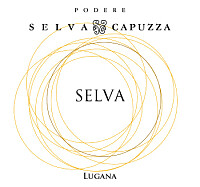
|
|
Lugana Selva 2018 |
|
| Selva Capuzza (Lombardy, Italy) | |
 Turbiana Turbiana | |
| Price: € 12.00 | Score: |
 Intense straw yellow and nuances of greenish yellow, very transparent. Intense straw yellow and nuances of greenish yellow, very transparent. Intense, clean, pleasing and refined, starts with hints of apple, plum
and citron followed by aromas of pear, hawthorn, broom, pineapple, peach,
almond and mineral. Intense, clean, pleasing and refined, starts with hints of apple, plum
and citron followed by aromas of pear, hawthorn, broom, pineapple, peach,
almond and mineral.
 Crisp attack and however balanced by alcohol, good body, intense
flavors, agreeable. Crisp attack and however balanced by alcohol, good body, intense
flavors, agreeable.
 Persistent finish with flavors of apple, plum and citron. Persistent finish with flavors of apple, plum and citron. Aged in steel tanks. Aged in steel tanks. |
|
 Pasta with fish, Sauteed fish, Sauteed white meat, Fried fish Pasta with fish, Sauteed fish, Sauteed white meat, Fried fish |
|
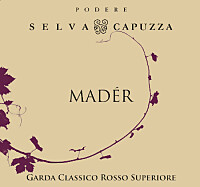
|
|
Riviera del Garda Classico Rosso Superiore Mader 2015 |
|
| Selva Capuzza (Lombardy, Italy) | |
 Groppello (30%), Barbera (30%), Marzemino (30%), Sangiovese (10%) Groppello (30%), Barbera (30%), Marzemino (30%), Sangiovese (10%) | |
| Price: € 13.00 | Score: |
 Intense ruby red and nuances of ruby red, little transparency. Intense ruby red and nuances of ruby red, little transparency. Intense, clean, pleasing and refined, starts with hints of cherry, plum
and blueberry followed by aromas of violet, blackberry, chocolate, tobacco,
black pepper, vanilla and menthol. Intense, clean, pleasing and refined, starts with hints of cherry, plum
and blueberry followed by aromas of violet, blackberry, chocolate, tobacco,
black pepper, vanilla and menthol.
 Properly tannic attack and however balanced by alcohol, good body,
intense flavors, pleasing crispness. Properly tannic attack and however balanced by alcohol, good body,
intense flavors, pleasing crispness.
 Persistent finish with flavors of cherry, plum and blueberry. Persistent finish with flavors of cherry, plum and blueberry. 18 months in barrique. 18 months in barrique. |
|
 Broiled meat and barbecue, Roasted meat, Stewed meat with mushrooms Broiled meat and barbecue, Roasted meat, Stewed meat with mushrooms |
|
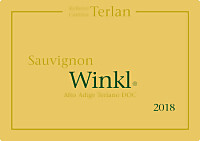
|
|
Alto Adige Terlano Sauvignon Blanc Winkl 2018 |
|
| Cantina Terlano (Alto Adige, Italy) | |
 Sauvignon Blanc Sauvignon Blanc | |
| Price: € 15.30 | Score: |
 Pale straw yellow and nuances of straw yellow, very transparent. Pale straw yellow and nuances of straw yellow, very transparent. Intense, clean, pleasing, refined and elegant, starts with hints of
gooseberry, peach and nettle followed by aromas of elder flower, passion
fruit, grapefruit, pineapple, apple, broom, pear and mineral. Intense, clean, pleasing, refined and elegant, starts with hints of
gooseberry, peach and nettle followed by aromas of elder flower, passion
fruit, grapefruit, pineapple, apple, broom, pear and mineral.
 Crisp attack and however balanced by alcohol, good body, intense
flavors, agreeable. Crisp attack and however balanced by alcohol, good body, intense
flavors, agreeable.
 Persistent finish with flavors of gooseberry, peach and passion fruit. Persistent finish with flavors of gooseberry, peach and passion fruit. 7 months in steel tanks and cask. 7 months in steel tanks and cask. |
|
 Risotto with fish and crustaceans, Vegetable soups, Dairy products, Sauteed crustaceans Risotto with fish and crustaceans, Vegetable soups, Dairy products, Sauteed crustaceans |
|
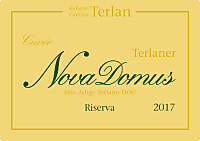
|
|
Alto Adige Terlano Bianco Riserva Nova Domus 2017 |
|
| Cantina Terlano (Alto Adige, Italy) | |
 Pinot Bianco (60%), Chardonnay (30%), Sauvignon Blanc (10%) Pinot Bianco (60%), Chardonnay (30%), Sauvignon Blanc (10%) | |
| Price: € 23.20 | Score: |
 Intense straw yellow and nuances of straw yellow, very transparent. Intense straw yellow and nuances of straw yellow, very transparent. Intense, clean, pleasing, refined and elegant, starts with hints of
apple, plum and banana followed by aromas of pear, tangerine, passion
fruit, grapefruit, melon, hawthorn, acacia, sage, mineral and hints of
vanilla. Intense, clean, pleasing, refined and elegant, starts with hints of
apple, plum and banana followed by aromas of pear, tangerine, passion
fruit, grapefruit, melon, hawthorn, acacia, sage, mineral and hints of
vanilla.
 Crisp attack and however balanced by alcohol, good body, intense
flavors, pleasing roundness. Crisp attack and however balanced by alcohol, good body, intense
flavors, pleasing roundness.
 Persistent finish with flavors of apple, tangerine and passion fruit. Persistent finish with flavors of apple, tangerine and passion fruit. 12 months in cask. 12 months in cask. |
|
 Stuffed pasta with fish, Broiled fish, Roasted fish, Roasted white meat Stuffed pasta with fish, Broiled fish, Roasted fish, Roasted white meat |
|
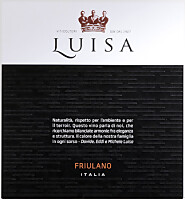
|
|
Friuli Isonzo Friulano 2018 |
|
| Luisa (Friuli-Venezia Giulia, Italy) | |
 Friulano Friulano | |
| Price: € 18.30 | Score: |
 Brilliant straw yellow and nuances of straw yellow, very transparent. Brilliant straw yellow and nuances of straw yellow, very transparent. Intense, clean, pleasing and refined, starts with hints of apple, plum
and pear followed by aromas of hawthorn, citrus fruits, pineapple, broom,
almond and mineral. Intense, clean, pleasing and refined, starts with hints of apple, plum
and pear followed by aromas of hawthorn, citrus fruits, pineapple, broom,
almond and mineral.
 Crisp attack and however balanced by alcohol, good body, intense
flavors, agreeable. Crisp attack and however balanced by alcohol, good body, intense
flavors, agreeable.
 Persistent finish with flavors of apple, plum and almond. Persistent finish with flavors of apple, plum and almond. 6 months in steel tanks, 2 months in bottle. 6 months in steel tanks, 2 months in bottle. |
|
 Pasta with fish, Sauteed fish, Broiled crustaceans, Dairy products Pasta with fish, Sauteed fish, Broiled crustaceans, Dairy products |
|
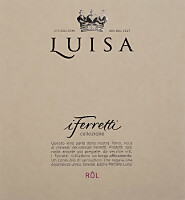
|
|
I Ferretti Rôl 2013 |
|
| Luisa (Friuli-Venezia Giulia, Italy) | |
 Merlot, Cabernet Sauvignon, Refosco dal Peduncolo Rosso Merlot, Cabernet Sauvignon, Refosco dal Peduncolo Rosso | |
| Price: € 34.15 | Score: |
 Intense ruby red and nuances of garnet red, little transparency. Intense ruby red and nuances of garnet red, little transparency. Intense, clean, pleasing, refined and elegant, starts with hints of
black currant, plum and black cherry followed by aromas of violet,
blueberry, cocoa, tobacco, leather, mace, thyme, licorice, vanilla and
menthol. Intense, clean, pleasing, refined and elegant, starts with hints of
black currant, plum and black cherry followed by aromas of violet,
blueberry, cocoa, tobacco, leather, mace, thyme, licorice, vanilla and
menthol.
 Properly tannic attack and however balanced by alcohol, good body,
intense flavors, pleasing roundness. Properly tannic attack and however balanced by alcohol, good body,
intense flavors, pleasing roundness.
 Persistent finish with flavors of black currant, black cherry and plum. Persistent finish with flavors of black currant, black cherry and plum. 30 months in cask, 24 months in bottle. 30 months in cask, 24 months in bottle. |
|
 Broiled meat and barbecue, Roasted meat, Stewed meat with mushrooms, Cheese Broiled meat and barbecue, Roasted meat, Stewed meat with mushrooms, Cheese |
|
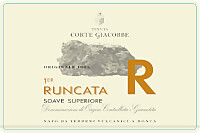
|
|
Soave Superiore Runcata 2017 |
|
| Corte Giacobbe (Veneto, Italy) | |
 Garganega Garganega | |
| Price: € 22.00 | Score: |
 Pale straw yellow and nuances of straw yellow, very transparent. Pale straw yellow and nuances of straw yellow, very transparent. Intense, clean, pleasing and refined, starts with hints of apple, peach
and broom followed by aromas of pear, hawthorn, chamomile, plum, rosemary,
sage and almond. Intense, clean, pleasing and refined, starts with hints of apple, peach
and broom followed by aromas of pear, hawthorn, chamomile, plum, rosemary,
sage and almond.
 Crisp attack and however balanced by alcohol, good body, intense
flavors, agreeable. Crisp attack and however balanced by alcohol, good body, intense
flavors, agreeable.
 Persistent finish with flavors of apple, peach and pear. Persistent finish with flavors of apple, peach and pear. 12 months in cask, 8 months in bottle. 12 months in cask, 8 months in bottle. |
|
 Pasta with fish and crustaceans, Sauteed fish, Mushroom soups, Sauteed white meat Pasta with fish and crustaceans, Sauteed fish, Mushroom soups, Sauteed white meat |
|
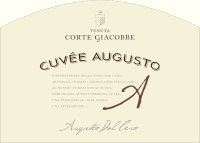
|
|
Lessini Durello Riserva Dosaggio Zero Cuvée Augusto 2013 |
|
| Corte Giacobbe (Veneto, Italy) | |
 Durella Durella | |
| Price: € 28.00 | Score: |
 Intense straw yellow and nuances of golden yellow, very transparent,
fine and persistent perlage. Intense straw yellow and nuances of golden yellow, very transparent,
fine and persistent perlage.
 Intense, clean, pleasing, refined and elegant, starts with hints of
apple, plum and bread crust followed by aromas of pear, grapefruit,
hawthorn, broom, chamomile, yeast, kiwi, almond and mineral. Intense, clean, pleasing, refined and elegant, starts with hints of
apple, plum and bread crust followed by aromas of pear, grapefruit,
hawthorn, broom, chamomile, yeast, kiwi, almond and mineral.
 Effervescent and crisp attack, however balanced by alcohol, good body,
intense flavors, agreeable. Effervescent and crisp attack, however balanced by alcohol, good body,
intense flavors, agreeable.
 Persistent finish with flavors of apple, plum and grapefruit. Persistent finish with flavors of apple, plum and grapefruit. The base wine is fermented and aged in cask and barrique. Refermented
in bottle on its lees for at least 50 months. The base wine is fermented and aged in cask and barrique. Refermented
in bottle on its lees for at least 50 months.
|
|
 Stuffed pasta with fish, Stewed fish with mushrooms, Roasted white meat Stuffed pasta with fish, Stewed fish with mushrooms, Roasted white meat |
|
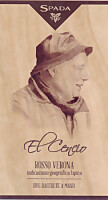
|
|
El Cencio 2016 |
|
| Spada (Veneto, Italy) | |
 Corvinone (80%), Cabernet Sauvignon (10%), Merlot (10%) Corvinone (80%), Cabernet Sauvignon (10%), Merlot (10%) | |
| Price: € 22.00 | Score: |
 Brilliant ruby red and nuances of garnet red, little transparency. Brilliant ruby red and nuances of garnet red, little transparency. Intense, clean, pleasing, refined and elegant, starts with hints of
black cherry, black currant and blackberry followed by aromas of violet,
blueberry, plum, raspberry, chocolate, tobacco, pink pepper, vanilla and
menthol. Intense, clean, pleasing, refined and elegant, starts with hints of
black cherry, black currant and blackberry followed by aromas of violet,
blueberry, plum, raspberry, chocolate, tobacco, pink pepper, vanilla and
menthol.
 Properly tannic attack and however balanced by alcohol, good body,
intense flavors, pleasing roundness. Properly tannic attack and however balanced by alcohol, good body,
intense flavors, pleasing roundness.
 Persistent finish with flavors of plum, black currant and blackberry. Persistent finish with flavors of plum, black currant and blackberry. Produced with dried Corvinone. 2 years in barrique. Produced with dried Corvinone. 2 years in barrique. |
|
 Broiled meat and barbecue, Stewed and braised meat, Roasted meat, Hard cheese Broiled meat and barbecue, Stewed and braised meat, Roasted meat, Hard cheese |
|
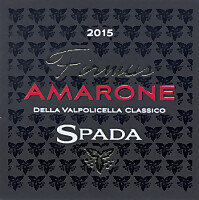
|
|
Amarone della Valpolicella Classico Firmus 2015 |
|
| Spada (Veneto, Italy) | |
 Corvina (45%), Corvinone (30%), Rondinella (20%), Molinara (5%) Corvina (45%), Corvinone (30%), Rondinella (20%), Molinara (5%) | |
| Price: € 28.00 | Score: |
 Brilliant ruby red and nuances of garnet red, moderate transparency. Brilliant ruby red and nuances of garnet red, moderate transparency. Intense, clean, pleasing, refined and elegant, starts with hints of
blackberry, plum and dried violet followed by aromas of black cherry,
blueberry, raspberry, tobacco, chocolate, cinnamon, mace, licorice, vanilla
and menthol. Intense, clean, pleasing, refined and elegant, starts with hints of
blackberry, plum and dried violet followed by aromas of black cherry,
blueberry, raspberry, tobacco, chocolate, cinnamon, mace, licorice, vanilla
and menthol.
 Properly tannic attack and however balanced by alcohol, full body,
intense flavors, pleasing roundness. Properly tannic attack and however balanced by alcohol, full body,
intense flavors, pleasing roundness.
 Persistent finish with flavors of blackberry, plum and black cherry. Persistent finish with flavors of blackberry, plum and black cherry. 3 years in cask. 3 years in cask. |
|
 Game, Roasted meat, Stewed and braised meat, Hard cheese Game, Roasted meat, Stewed and braised meat, Hard cheese |
|
|
||||||||
|
DiWineTaste Polls
|
| |||||||
Privacy Policy | |||||||


| Copyright © 2002-2024 Antonello Biancalana, DiWineTaste - All rights reserved |
| All rights reserved under international copyright conventions. No part of this publication and of this WEB site may be
reproduced or utilized in any form or by any means, electronic or mechanical, without permission in writing from DiWineTaste. |